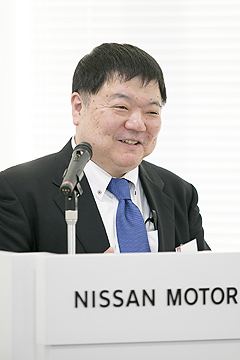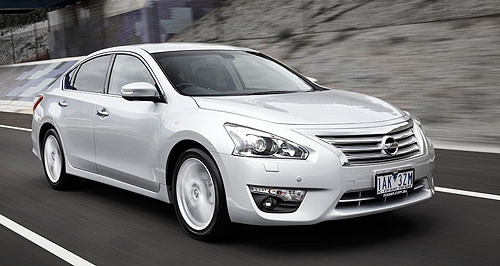News - NissanSales downturn behind Emery exit: NissanVolume switch: New product and marketing ‘actions’ are coming as Nissan puts a new strategy in place in Australia, but the new 2018 Leaf unveiled this week is the only all-new passenger car confirmed at this stage. Regional Nissan chief says ‘we can perform more’ in Australia as new MD takes office8 Sep 2017 By DANIEL DeGASPERI in TOKYO NISSAN Motor Corporation’s Asia and Oceania region chief Yutaka Sanada has confirmed that former Nissan Australia managing director and CEO Richard Emery, who made a shock departure from the company last week, was replaced due to the declining sales performance of the brand in this market – among other factors. Speaking at the unveiling of the new Leaf electric vehicle in Tokyo this week, Mr Sanada told GoAuto that the Japanese car-maker must now use its experience in other markets to help turnaround its sales in Australia. “I think we are always intending to expand our presence in a territory, and I think we have a strong SUV line-up – X-Trail, Qashqai, Pathfinder and Patrol,” Mr Sanada said. “So I think knowing our worldwide presence in a similar market, we believe we can attract a customer more. I think not only product actions, but maybe more marketing actions … can attract those extra customers. “We can perform more.” Mr Sanada last week announced that Mr Emery had left the company and his replacement – former Infiniti Canada managing director Stephen Lester – would take charge immediately. Asked whether Nissan Australia’s declining sales volumes were the reason for the management change, Mr Sanada replied: “Yes, one of the reasons is yes, we want to expect a further presence (in Australia). “I think we are preparing the next step about some plan with this, because also we have significant passenger customer in Australia. “We have the product, and then we have the plan for the future. But it is not yet (communicated).” While Mr Emery was committed to Nissan’s participation in Supercars racing in Australia, Mr Sanada revealed that any future involvement in the native racing series was now under review. Nissan has only signed with Supercars until the end of 2018, using the body of the now-discontinued Altima large sedan. “I think we are always keeping some intention and trying to join some motorsports activity,” Mr Sanada said. “Our customer expects some activity in this field, and also you have Nismo brand – we recently launched 370Z Nismo. “This future plan is under discussions now.”  Left: Nissan Motor Corporation Asia and Oceania region chief Yutaka Sanada Left: Nissan Motor Corporation Asia and Oceania region chief Yutaka SanadaNissan Motor Corporation regional sales and marketing executive Vincent Wijnen – to whom Mr Lester will report – likewise indicated that a future in Supercars was not set in stone for the car-maker. “There is no specific decision on this (Supercars),” Mr Wijnen said. “I don’t think it’s the issue of whether the car is the Altima. What is the role in motorsports going forward? There’s no conflict in being in motorsport and having a Nismo brand and investing in a car like Leaf. “The motorsports brings excitement and you’re also seeing more and more electrifying (of racing), maybe not yet in Australia … so in that sense we do need to evaluate.” As GoAuto has reported, Nissan’s sales were already on a downward trajectory when Mr Emery – an experienced Australian motor industry executive with some 30 years’ experience – took the reins in April 2014. Volume fell from 79,747 sales in 2012 to 66,026 units by the end of 2014, and remained at the 66K mark in 2015 and 2016. To the end of August this year, sales are down 14.1 per cent on the same period last year. Mr Emery’s “long game” strategy saw Micra, Pulsar, Altima and other vehicles dropped from the line-up until new models could prove more competitive – and improve sales volume – compared with their predecessors. Its 370Z and GT-R sportscars are the only passenger cars remaining in the line-up, with the new Leaf set to make a comeback with the new generation due late next year. But Mr Wijnen said a new strategy would be put in place. “We will not win the volume game with just Leaf, we will have to have a range that matches the Australian customers’ wants,” he said. “We have clearly chosen that in SUV we want to be very strong, that’s also our strength as a company, but that doesn’t mean that we are not looking at some other options in terms of strengthening the range to drive that growth in the mid-term – but mid-term is not very long in the car industry.” Asked whether the decision to axe the Thai-built Pulsar could be reversed in this existing generation, Mr Wijnen said: “I cannot be that specific. “But the point is that we are working on this now to ensure the product line-up is further strengthened in a reasonable period of time.” Nissan Australia product management general manager Chris Shultz was likewise committed to reintroducing passenger vehicles to the market when they are ready, however he was more doubtful about any comeback of the current Pulsar. “My immediate answer would be probably unlikely, but … with a management change it’s something that maybe we’ll look at studying,” he said. “I think with our resources you’re better off focusing on what you’re doing really well and the segments that are growing. Pulsar wasn’t performing as well as we wanted it to perform. “(But) I wouldn’t say (Leaf) is going to be our only passenger car. We’re studying a lot of options. There are a lot of these cars globally that we’re studying.” Mr Shultz admitted “Juke doesn’t perform as well locally as we’d like it to perform” and added that “from my point of view we would like a car that is under $20,000 in the portfolio but globally from a profit or volume perspective there are many different aspects that go into it (decisions)”. The chances of a $19,990 Juke to sit alongside the Mazda CX-3 Neo are, however, slim. “It (Juke) is not really where it’s pitched,” Mr Shultz said. “It’s a segment Nissan partly created in Europe … but at a premium price point. Whereas now, CX-3s are at that lower price point."Whereas Qashqai and X-Trail are seen as strong performers, the competitiveness of other models such as Micra or a return to selling light-commercial vehicles were questioned by Mr Shultz – with the only Nissan vans available being the Renault Trafic-sized NV200 and Renault Master-based NV400. “We’re looking at European Micra, we constantly look at all the other markets and think, ‘What car could work?’” he said. “(But) European Micra is pitched to a slightly different market than really what we need, it’s a much more premium vehicle, it really is a (Volkswagen) Polo, it’s pitched at the European competitors. “(LCV) is something that we’ve talked about and are currently talking about. It’s quite a hard market in vans because they’re very low profit and high volume. There are other manufacturers that do vans quite strongly at the moment and they’ve got quite a broad range – so to step into it in only one area of the segment would be quite difficult”.  Read more |
Click to shareMotor industry news |

















Facebook Twitter Instagram